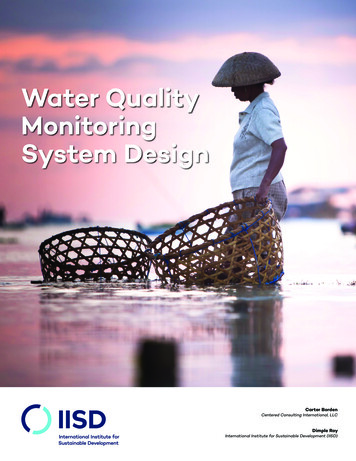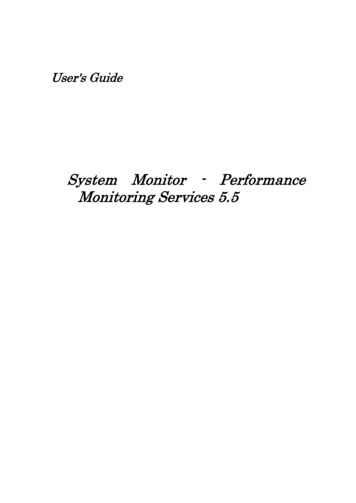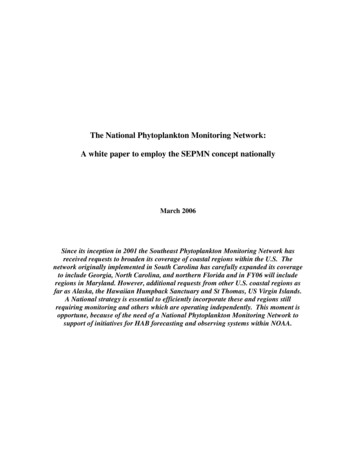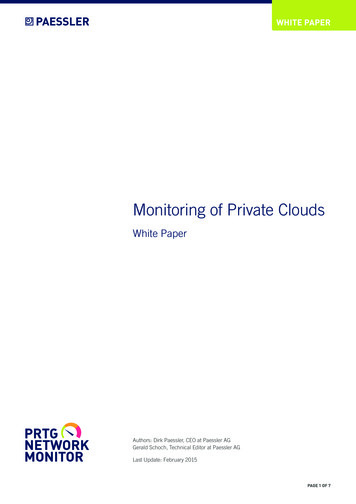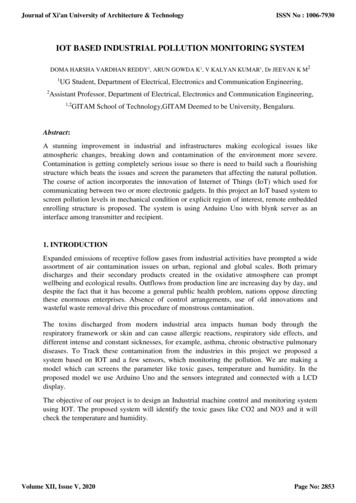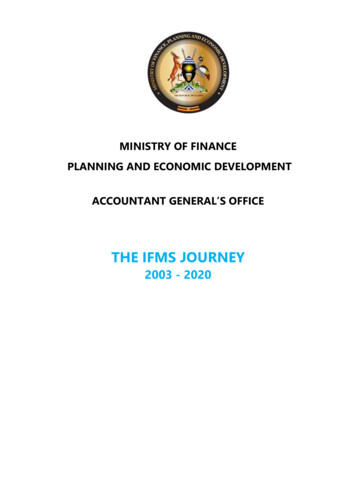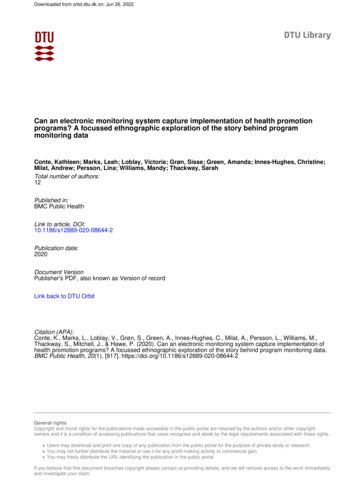
Transcription
Downloaded from orbit.dtu.dk on: Jun 26, 2022Can an electronic monitoring system capture implementation of health promotionprograms? A focussed ethnographic exploration of the story behind programmonitoring dataConte, Kathleen; Marks, Leah; Loblay, Victoria; Grøn, Sisse; Green, Amanda; Innes-Hughes, Christine;Milat, Andrew; Persson, Lina; Williams, Mandy; Thackway, SarahTotal number of authors:12Published in:BMC Public HealthLink to article, DOI:10.1186/s12889-020-08644-2Publication date:2020Document VersionPublisher's PDF, also known as Version of recordLink back to DTU OrbitCitation (APA):Conte, K., Marks, L., Loblay, V., Grøn, S., Green, A., Innes-Hughes, C., Milat, A., Persson, L., Williams, M.,Thackway, S., Mitchell, J., & Hawe, P. (2020). Can an electronic monitoring system capture implementation ofhealth promotion programs? A focussed ethnographic exploration of the story behind program monitoring data.BMC Public Health, 20(1), [917]. https://doi.org/10.1186/s12889-020-08644-2General rightsCopyright and moral rights for the publications made accessible in the public portal are retained by the authors and/or other copyrightowners and it is a condition of accessing publications that users recognise and abide by the legal requirements associated with these rights. Users may download and print one copy of any publication from the public portal for the purpose of private study or research. You may not further distribute the material or use it for any profit-making activity or commercial gain You may freely distribute the URL identifying the publication in the public portalIf you believe that this document breaches copyright please contact us providing details, and we will remove access to the work immediatelyand investigate your claim.
Conte et al. BMC Public Health(2020) SEARCH ARTICLEOpen AccessCan an electronic monitoring systemcapture implementation of healthpromotion programs? A focussedethnographic exploration of the storybehind program monitoring dataKathleen Conte1,2,3*†, Leah Marks1,2†, Victoria Loblay1,2, Sisse Grøn1,2,4, Amanda Green5, Christine Innes-Hughes5,Andrew Milat6, Lina Persson6, Mandy Williams7, Sarah Thackway6, Jo Mitchell8 and Penelope Hawe1,2AbstractBackground: There is a pressing need for policy makers to demonstrate progress made on investments inprevention, but few examples of monitoring systems capable of tracking population-level prevention policies andprograms and their implementation. In New South Wales, Australia, the scale up of childhood obesity preventionprograms to over 6000 childcare centres and primary schools is monitored via an electronic monitoring system,“PHIMS”.Methods: Via a focussed ethnography with all 14 health promotion implementation teams in the state, we set outto explore what aspects of program implementation are captured via PHIMS, what aspects are not, and theimplications for future IT implementation monitoring systems as a result.Results: Practitioners perform a range of activities in the context of delivering obesity prevention programs, butonly specific activities are captured via PHIMS. PHIMS thereby defines and standardises certain activities, while noncaptured activities can be considered as “extra” work by practitioners. The achievement of implementation targets isinfluenced by multi-level contextual factors, with only some of the factors accounted for in PHIMS. This evidencesincongruencies between work done, recorded and, therefore, recognised.(Continued on next page)* Correspondence: Kathleen.conte@sydney.edu.au†Kathleen Conte and Leah Marks contributed equally to this work.1The Australian Prevention Partnership Centre, Ultimo, Australia2Menzies Centre for Health Policy, School of Public Health, Faculty ofMedicine and Health, University of Sydney, Sydney, AustraliaFull list of author information is available at the end of the article The Author(s). 2020 Open Access This article is licensed under a Creative Commons Attribution 4.0 International License,which permits use, sharing, adaptation, distribution and reproduction in any medium or format, as long as you giveappropriate credit to the original author(s) and the source, provide a link to the Creative Commons licence, and indicate ifchanges were made. The images or other third party material in this article are included in the article's Creative Commonslicence, unless indicated otherwise in a credit line to the material. If material is not included in the article's Creative Commonslicence and your intended use is not permitted by statutory regulation or exceeds the permitted use, you will need to obtainpermission directly from the copyright holder. To view a copy of this licence, visit http://creativecommons.org/licenses/by/4.0/.The Creative Commons Public Domain Dedication waiver ) applies to thedata made available in this article, unless otherwise stated in a credit line to the data.
Conte et al. BMC Public Health(2020) 20:917Page 2 of 17(Continued from previous page)Conclusions: While monitoring systems cannot and should not capture every aspect of implementation, betteraccounting for aspects of context and “extra” work involved in program implementation could help illuminate whyimplementation succeeds or fails. Failure to do so may result in policy makers drawing false conclusions aboutwhat is required to achieve implementation targets. Practitioners, as experts of context, are well placed to assistpolicy makers to develop accurate and meaningful implementation targets and approaches to monitoring.Keywords: Health promotion, Performance monitoring, Prevention, Obesity, Implementation science, Ethnography,Health policy, Health management, Scale up“The tick in [the PHIMS information system] is likethe tip of an iceberg. It's that tiny bit above the surface. And behind it is years of chatting, visits, gentlyurging, suggesting they go in this direction ratherthan that direction.” – Quote captured in ethnographic fieldnotes, Team GBackgroundThere is broad agreement that policy-level investment inpopulation-level health promotion is needed and effectivein keeping people healthy and reducing health costs [1, 2].But health promotion has often struggled to maintainfunding and political support [3]. Policy makers andpopulation-level program coordinators are therefore facedwith a pressing need to demonstrate progress on investments in health promotion. Information technology (IT)systems hold promise to assist policy makers in trackingdelivery of population-level health programs and theachievement of implementation targets, but there are veryfew examples of their use in population health contexts [4].In clinical contexts, IT systems have a long history ofdesign, use, and often, abandonment [5, 6]. The design,implementation, success and failures of electronic healthrecords, for example, constitute a wealth of experiences,evaluation and research. This history provides a richsource of material by which to inform, debate, and interrogate the value, design, and standards for best use andimplementation of electronic health records [7, 8]. In thecontext of using IT systems to monitor the implementation of population-level health programs these conversations are only just beginning. There are signs thatcurrent systems designed for research purposes fail totranslate to everyday practice [9]. And that some systemsdesigned for monitoring health promotion and prevention programs are overly onerous, resulting in push-backfrom users and, ultimately, abandonment despite considerable financial investments [10].As more health promotion programs are scaled up to bedelivered at the population-level, the demand for IT systemsto monitor implementation will increase. Such systems needto effectively capture and monitor implementation progressfor coordination across sites. However, processes by whichto effectively monitor, implement and sustain programs atscale are understudied [11, 12]. This includes research onmonitoring systems for health promotion programs delivered at scale, particularly because there are very few examples of these IT systems to study [4].In New South Wales (NSW), Australia, the Ministry ofHealth designed and rolled-out an over AU 1 million ITimplementation monitoring system, Population Health Information Management System (PHIMS), to facilitate andtrack the reach and delivery of state-wide childhood obesityprevention programs called the Healthy Children Initiative(HCI) [13]. PHIMS is unique in that it has sustained implementation since 2011, whereas many IT systems – in clinical and population health- have failed [4]. It presents aunique opportunity to examine the use of IT systems totrack large-scale implementation. We set out to explorewhat aspects of implementation are captured via this ITmonitoring system, what aspects are not, and the implications for future IT implementation monitoring systems.Our purpose was to gain insights that might improve coherency between what a recording system captures andwhat it really takes to achieve implementation.The findings in this paper are part of a larger studythat examined the dynamics between PHIMS use andhealth promotion practice [14]. The Monitoring Practicestudy was co-produced via a partnership with state-levelpolicy makers and program managers for HCI, PHIMStechnical designers, health promotion practitioners, anduniversity-based researchers – all of whom are coauthors of this paper. While the university-basedresearchers (hereafter called ‘researchers’) led the collection and analysis of data, the roles played by the widerco-production team served to help position and interpretthe findings within the broader context of HCI implementation (more information about the roles and contributions of team members are in Additional file 1). Theresearch questions guiding this analysis were developedwith the partners at study’s outset and are:1. What constitutes/is the breadth of work involved insupporting early childhood services and primaryschools to achieve HCI practices?
Conte et al. BMC Public Health(2020) 20:9172. What constitutes/is the intensity of work?3. To what extent are breadth and intensity capturedby PHIMS?ContextPHIMS was designed to support the implementation ofthe Healthy Children Initiative (HCI) – Australia’s largest ever scale-up of evidence-based obesity preventionprograms, which includes programs delivered in approximately 6000 early childhood services and primaryschools across NSW. Two particular HCI programs,Munch and Move and Live Life Well at School (hereafter referred to as HCI), are delivered by 14 health promotion teams that are situated within 15 local healthdistricts across the state. To date, these HCI programsare currently reporting high rates of participation, reaching over 89% of early childhood services (3348/3766)and 83% of primary schools (2133/2566) [15].The PHIMS system is described in detail elsewhere[15, 16]. It is used to track the adoption of healthy eatingand physical activity practices in schools and services(See Additional file 2 for full list of practices) for Munchand Move and Live Life Well at School. Site-level progress is aggregated via PHIMS and enables district andstate-level coordinators to track district-level progressagainst key performance indicator (KPI) targets. Accessto PHIMS is restricted via a state-wide login service,where user access is configured according to roles. Userroles include 1) health promotion practitioners who access and input notes and record progress towards implementation targets for their assigned sites; 2) supervisorswho can access all information entered by their staff forsites in their health district; and 3) state-level managerswho can only access aggregated data reporting progresstowards KPI target achievement at the health districtlevel.MethodsData collectionOur approach to data collection was consistent with focussed ethnography. Focussed ethnography is a shortterm, high-intensity form of ethnography where shortvisits to the field (or, relatively short in comparison withtraditional ethnography) are balanced with extensivepreparation, focussed selection and attention on specificactivities and sites relevant to the research questions,use of multiple data sources, and intense, iterative, andcollaborative analysis of data [17, 18]. Preparatory workfor this study began 1-year prior to field visits during which time researchers conducted informal interviews with study partners, attended PHIMSdemonstrations and reviewed documentation, met withsites to discuss the approach, and conducted a thoroughreview of a range of theories as a sensitisation tool [14].Page 3 of 17The fieldwork was conducted with all 14 local healthpromotion teams funded to deliver HCI programs acrossNSW. Over 12 months, three researchers (KC, VL, SG)spent between 1 and 5 days in each health district observing the day-to-day implementation work conductedby health promotion practitioners who delivered theHCI programs. Researchers collected extensive fieldnotes, pictures, recordings from ad hoc interviews, andprogram materials that were compiled in an NVIVOproject database [19]. In total, we shadowed, interviewedor observed 106 practitioners across all 14 teams. Researchers recorded their observations as soon as possibleafter leaving the field yielding over 590 pages of detailedfield notes. Regular meetings between the researchersenabled iterative, theory-informed dialogue and analysisand reflection on the interpretations arising throughanalysis. Ongoing correspondence with participants inthe field and regular meetings with the broader coproduction team allowed the representation of findingsin field notes to be further critiqued and interpreted.This group approach to analysis and interpretation reduces the subjectivity of field notes by enabling interpretations to become shared by those they are about, ratherthan the purview of a lone ethnographer [17]. While rawfield notes were only shared among the researchers andsometimes with participants whom they were about,only de-identified or abstracted data were shared withthe broader co-production team and in public forums.We used the consolidated criteria for reporting qualitative research (COREQ) guidelines [20] to guide thereporting of our study (see Additional file 1).Data analysisWe used a grounded theory approach to code thematerials in the project database, and to generate aninitial project codebook, as described more fully elsewhere [14, 21, 22]. For this subsequent analysis, weused both a deductive and inductive approach [23].Two researchers (KC and LM) collaborated in an iterative process of coding, reflection, and theming thedata. For the deductive analysis, we extracted datafrom 15 codes we determined were most relevant tothe research questions (see Additional file 3 for listand description of codes). Using a directed contentanalysis approach [24], we recoded this data to develop new codes related to “breadth” and “intensity,”as defined a priori (see definitions in Table 1) andgenerated a list of activities, strategies and resourcesthat reflected the breadth of HCI activities. An initialcoding scheme was developed and operational definitions for each category were defined and iterativelyrevised. We revised our coding list and recoded thedata until no new codes emerged and theoretical saturation was reached. Through this process, we
Conte et al. BMC Public Health(2020) 20:917Page 4 of 17Table 1 Definitions of “breadth” and “intensity” as operationalised in this analysisTermDefinitionBreadthThe range & type of activities, strategies and/or resources involved in day-to-day implementation work by health promotion practitioners indelivering the HCI programsIntensity The amount of time and effort these activities take (e.g. duration and frequency of the activity and how many steps involved incompleting an activity) and the value placed on the activity by practitionersproduced a rough ‘taxonomy’ of categories of activities involved in HCI implementation.Whilst this approach worked well for research question 1 regarding “breadth,” we found few examples of“intensity” using this approach. It was difficult to observeand interpret “intensity” in our field notes, and becauseour study was cross-sectional, we were unable to fullyobserve “intensity” in practice. However, many practitioners discussed this issue so we adopted a groundedtheory approach to better explore what “intensity” ofwork looked like in our dataset. Through an iterativeprocess of discussions with the ethnographers, usingNVIVO tools to expand coding to the broader context,and reading many field notes in their entirety, we inductively developed codes by coding data line-by-line,and subsequently looking for overall patterns.To answer the third research question, we codeddata that spoke to two overarching, abstracted questions throughout the entire coding process: a) “Is atick in PHIMS a true reflection of the work done?”,and b) “How is breadth/intensity of work captured inPHIMS?” The second question was not an analysis ofPHIMS content, but rather, what we observed orlearned about PHIMS during our field work. Therefore, to answer this question we drew both on datafrom ethnographic field notes, memos created duringcoding, and our knowledge of the PHIMS system developed over the course of the full project (e.g.through demonstrations of PHIMS, training manuals,conversations with PHIMS developers, etc). The leadauthors met frequently during the coding process todiscuss emerging insights, as well as met with theother researchers to discuss possible interpretationsand interesting examples. Through this iterativeprocess, we moved from concrete codes that are descriptions of activities to more abstract, thematicgroupings and generalizations which we report in ourresults, along with a thematic conceptual model (presented later) [25].The analyses were concurrent, occurring alongsideregular meetings with the full research team and partners where emergent findings and interpretations werediscussed and collaboratively explored. Coding and insights therefore developed iteratively whilst projectmeetings enabled feedback and reflection to be incorporated as part of the analysis process. We presented initialfindings to partners for comment and reflection.Results“Breadth” of work to implement HCIWe sorted activities used by teams and practitioners todeliver HCI into 15 groupings (see Table 2). Thesegroupings reflected two overarching purposes: 1) workinvolved in the implementation of HCI; and 2) work required to convert implementation work into PHIMSdata. We explore these activities and how they are captured in PHIMS below. The groupings were not mutually exclusive, with specific activities often meetingmultiple purposes (e.g. site visits are used for networking, distributing resources, team work, and other purposes). The types of activities within each grouping werediverse and implemented differently across teams. Forexample, we observed some teams devoting many hoursand financial resources to activities categorised as “developing HCI resources” however, others drew mainlyfrom centrally distributed HCI materials. Notably, therewas no one way to implement HCI. Practitioners wereaware that HCI implementation activities differed fromteam to team. They were notably curious to learn fromthe researchers how their approach matched or differedfrom other teams.Work involved in implementing HCIThis category represents work tasks that constitute foundational components for delivering HCI to achieve implementation targets. Many of the activities wereobserved across all teams, but there was diversity in thespecific tasks and styles by which individual activitieswere implemented. For example, “site visits” constituteda large proportion of practitioners’ work in every team,but approaches varied with some teams conductingregular, in-person meetings whilst others rarely visitedin-person or conducted visits electronically, i.e. viaphone or email (variations will be discussed in more detail later).Some practitioners described doing work with siteswho had already achieved 100% of their implementationtargets. The sense from practitioners was that this responsive or self-directed work was different from or inaddition to the main work involved with implementingHCI. Sometimes this work was done to maintain practices and achievements. We also observed practitionerstaking on projects or activities in response to needsidentified by the local community or HCI site (e.g. tobetter reach culturally and linguistically diverse
PHIMS functionality for capturing this workaSome practitioners keep detailed notes in PHIMS to provide theirteam with a full overview of the site and to keep a record forother practitionersb.As above, and practitioners use PHIMS to record training status.Some practitioners also include qualitative notes about how theworkshop went, and how much progress they madea.Free-text boxes in PHIMS allow users to enter notes about sitevisits. PHIMS does not have functionality to quantify the workinvolved, including the time it takes to complete the site visit.PHIMS has “alert” functions for scheduled follow-ups with sites at1, 6- and 12-month intervals. If a site visit is not documented inPHIMS within a specified time window, the practitioner and theirsupervisor are notified.Site details and notes can be shared among team members atthe supervisor’s discretion.PHIMS allows user to schedule ‘training’, to mark invitations sentand to mark training completed. Workshop attendees areentered into PHIMS individually, and each recorded as trained.PHIMS also has a function to update training status of multipleusers or sites in-bulk. There is no function to record other typesof workshops, e.g. hosted to support general program delivery.Scheduled follow-ups are specifically designed to facilitate organ- Some practitioners cut and paste emails with contacts intoisational work by providing a record of due dates and reminders. PHIMS’ ‘additional contact notes’ – a free form note taking dataPHIMS has rudimentary functionality to send/save emails.fielda.Site visits: Work involved in preparing for and conducting asite visit, including scheduled follow-ups.Team work: How HCI teams work together to conduct thework and achieve implementation targets (E.g. collaborationand team work within HCI teams, or with other districts)Workshops (in-services): Work involved in organising, andhosting in-services (training workshops with teachers in orderto teach them and meet the training requirements for certainpractices)Organisational work: Basic work tasks required to supportand keep track of HCI work (E.g. keeping notes on scheduledfollow ups, saving emails, cancellations and reorganising sitevisits)Practitioners can input training dates, invitations sent andwhether sites attended trainings, which are often held inconjunction with meetings. It cannot track sites' registration.Use of PHIMS reports varies dependent on skill of users andteams. Some teams with superusers generate bespoke, detailedNetwork meetings are used by some practitioners to collectinformation on practice adoption and update quantitativeimplementation data in PHIMS.Practitioners use the contact details for sites contacts. SomeAs above. PHIMS has ability to keep record of “contacts” (e.g.practitioners also record details about their interactions withphone calls, emails) with site contacts.b PHIMS has functionalityto do bulk updates for multiple sites at once, which can be used sites.to record the distribution of resources (newsletters) to all servicesor when an practitioner has phoned/emailed all their services toprovide information or invite them to a training/informationsession.(2020) 20:917Strategic work: Work done to achieve implementationPHIMS reports (including customizable reports) are available totargets or implement practices in a strategic manner. (E.g. how assist with strategic work.Network meetings: Work involved in coordinating andrunning network meetings. Network meetings are used toengage and have more contact with site staff, offer a supportnetwork and may provide them with training that helps meetimplementation targetsNetworking, communication and relationship building withsites: The extent of networking, communication and buildingrelationships required with sites in order to satisfy a tick (E.g.how practitioners interact with sites (emails, phone calls), buildrelationships with contacts and work in partnership with sites)Site details are loaded into PHIMS by central management either Most work about practitioners’ process to recruit and onboardsites prior to becoming ‘active’ in PHIMS is recorded in alternatethrough database updates, or upon request from users. PHIMSsystems.has ability to keep record of contacts details including contactainformation and training status of active sites and staff.HCI Pre-work: Work that builds the foundation forimplementation of program practices (e.g. onboarding newsites, action planning, getting sign-off, data agreements andconsent from sites to collect implementation data)All teams enter data to record practice achievement; someteams have a dedicated PHIMS ‘champion’ to record this data,whereas in others, each practitioner is responsible for enteringdata on their sites. The amount of detail entered about the sitevisit varies depending on individual practitioners.No specific function to record work involved in resourcedevelopment and distribution in PHIMS.Some practitioners choose to enter notes about materialsdistributeda. No observed instances of users using PHIMS todocument resource development.Variability in approaches by PHIMS usersaDevelopment of HCI resources and materials: Theresources produced and distributed by practitioners tosupport the delivery of HCI programs (e.g. factsheets,newsletters, Facebook and social media accounts,questionnaires)1. Work involved in implementing HCI programs and practicesThe range and types of activities involved in the dailyimplementation of HCITable 2 The breadth (range & types) of work involved in the implementation of the Healthy Children Initiative and how it is recorded in PHIMSConte et al. BMC Public HealthPage 5 of 17
No specific functionWork that addresses a site’s self-identified needs: Thiswork may or may not align with achieving a particularpractice, and may be responding to a sites’ need or requestthat differ from the aims of HCIPHIMS is not available via mobile devices and is difficult toaccess from non-team computers, so data entry is usually donein the team office.Practice achievement status is recorded in PHIMS via a multiplechoice survey. PHIMS provides a printable template for datacollectionPHIMS has “alert” functions for scheduled follow-ups with sites at We did not observe that PHIMS records information about user1, 6 and 12 month intervals. So, if this data is not recordedbehaviour (e.g. active time spent on PHIMS, number of log-in oralready, the practitioner is advised.date of last log-in).Collecting implementation data in sites: How practitionersgo about collecting information on practice achievementData entry in PHIMS: Inputting information from site visits,and other HCI activities into PHIMS to record progress andachieve a tick (i.e., target practice adopted in the site)PHIMS Population Health Information Management System, HCI Healthy Children InitiativeaPHIMS contains a ‘notes’ function with a limited character allowance that users may use at their discretion. Practitioners may use this functionality to record information about the types of activities in implementingHCI. We have noted instances where we observed this function being used to record tasks or instances where we expect it might be used. However, the notes function lacks search and retrieval functions to be ableto thoroughly assess contentbNote that the ability to record this information and the ability to later retrieve it in a useful and meaningful way is an important distinctionSome teams have internal discussions to interpretimplementation targets and determine a consistent minimumstandard for ticking a practice. We didn’t observe theseconversations being documented using PHIMS.Some practitioners may document this work in notesaInterpreting what program adoption looks like:PHIMS lists each practice that must be reported against (seeCollaborative or deductive work to interpret practices to know Additional file 2 for the practices). It does not providewhat practitioners must report oninterpretative guidance, but a monitoring guide is available toassist with interpretation.2. Performance monitoring work required to convert the work done into PHIMS dataNo specific functionSelf-directed work of HCI Team members: Work tasks/activities that practitioners choose to do or have specialinterest in that may or may not align with HCI program goalsSome practitioners may document this work in notes aSome practitioners may document this work in notesaNo specific functionFlexible work to support HCI work and practiceimplementation: Work involved in the development of newmaterials that assist in achieving HCI practices. (E.g. an app tohelp teach fundamental movement skills, an informationalhandout, school veggie gardens)Variability in approaches by PHIMS usersareports while others use this function sparingly, if at all.PHIMS functionality for capturing this workathe team makes decisions, weighs options, plan and usesresources to achieve targets)The range and types of activities involved in the dailyimplementation of HCITable 2 The breadth (range & types) of work involved in the implementation of the Healthy Children Initiative and how it is recorded in PHIMS (Continued)Conte et al. BMC Public Health(2020) 20:917Page 6 of 17
Conte et al. BMC Public Health(2020) 20:917communities). Often – but not always- this work complement
monitoring systems for health promotion programs deliv-ered at scale, particularly because there are very few exam-ples of these IT systems to study [ 4]. InNewSouthWales(NSW),Australia,theMinistryof Health designed and rolled-out an over AU 1 million IT implementation monitoring system, Population Health In-


